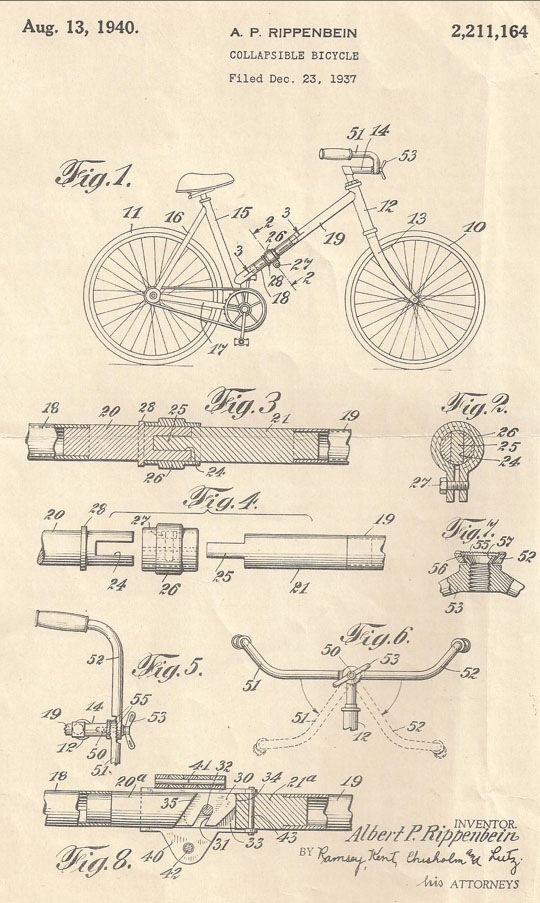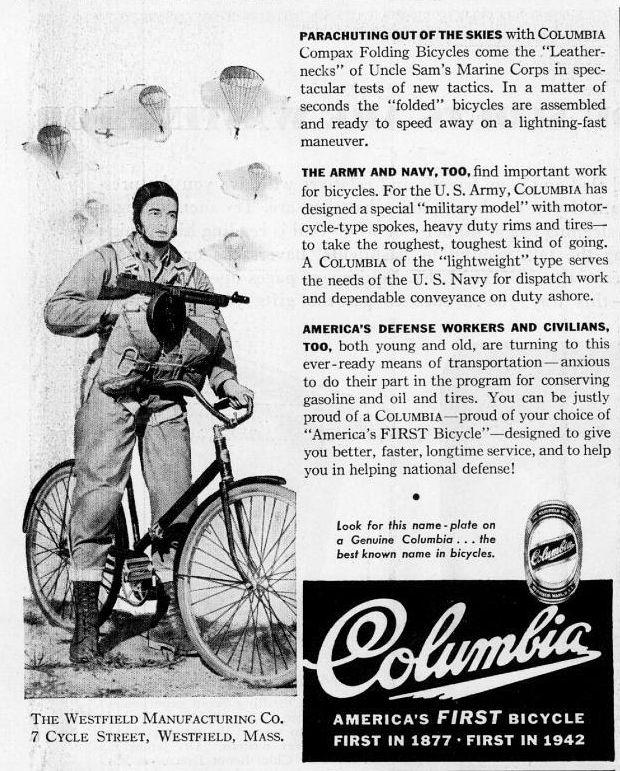
In 1938, the Compax Mfg Co. Inc. introduced its Compax Vagabond Folding bike. This bike was designed for easy transport and was targeted to apartment dwellers, yachtsmen and vacationers along with daily commuters. It did not take long for Westfield Mfg Co, the makers of Columbia bikes, to take note of this bike – they wanted it in their line of bikes. The very next year Westfield purchased the company and patent for this bike. In 1940, the first Westfield made Compax bikes went into production now called the Compax Sports Traveler.
The 1940 and 1941 Westfield Compax bikes differed slightly from the Compax Company’s bike but kept all of the important design features that made this bicycle unique, folding handlebars and a take-apart frame.
Vacationers were not the only target Westfield Mfg had in mind for this bike. For several years war was brewing with Japan and the idea of a lightweight compact bike was being entertained by the US Military. Almost two years before the Japanese attack on Pearl Harbor the US Marines were experimenting with take-apart bikes and used a Westfield made Compax in Marine Paratrooper trials. These tests would lead to the Paratrooper name and legend. The fact of the matter is the U.S. Military never approved these bikes for paratrooper use. This did not mean the makers of Columbia bicycles did not give up on the idea of selling these bikes to the military. Many were purchased by the military for use on bases. The following is the pre-war publicity picture depicting the marine paratrooper trials. This picture was used by Westfield Mfg during and after the war in ads to promote their participation in the war effort.
– Ken Kowal (“Mr. Columbia”)
Columbia bicycles were used by the military during WW1, and the company were keen to supply the military during WW2 as well. Their bicycles were used by civilian personnel at military bases and the military tried out the Compax ‘folding’ bicycle too. Nevertheless, although bicycles were vital for secondary service during WW2, their use by the American forces in the field of war was limited. It seems that the US Army did have them in reserve, but there are no records of their specific use during war-time missions.
After the war, Columbia capitalized on the military use of their bicycles, and the folding Compax model was named the ‘Compax Paratrooper’ for the civilian market; this name is visible on the head-badge, while the transfer (decal) on the down tube reads ‘Compax Sports Traveler THE FOLDING BIKE.’


1946 Columbia Compax
‘Sports Traveler’ Folding Bicycle
Folding handlebars
New Departure coaster brake
1946 West Milwaukie License plate
18.5″ Frame
26″ Wheels


in the 1890s, Colonel Pope established a pattern of buying up every patent possible. As a result, Columbia bicycles featured the most innovative designs. Half a century later, the Compax Paratrooper follows this same tradition, and the bike itself does not disappoint. The adjustable handlebars are reminiscent of ‘Kelly Adjustables’ from around the turn of the century (mostly used on Racycle bicycles). Another nice design touch is its ‘gothic’ fenders, and I like its minimalism too: no lamp brackets or accessories pictured in the catalogue illustrations.
This Compax is in unrestored original condition, with nice red paintwork and its original decal on the down tube. The tyres are a little cracked but are functional, and the surface rust on the brightwork needs polishing out. It folds easily and is ready to ride and display.
The diagram below illustrates how this bicycle folds …except that ‘America’s first folding bicycle’ does not actually fold at all – actually, it breaks into two parts. Nevertheless, it is a neat design and ideally suited for its target market. Later folding bicycles were, of course, lightweight machines, while this is medium weight. What I particularly like about the Compax Paratrooper is that it is the only ‘folding’ balloon-tire style bicycle.








Above you can see the postwar Compax Paratrooper model; below is the army version, with wooden pedals.































































































